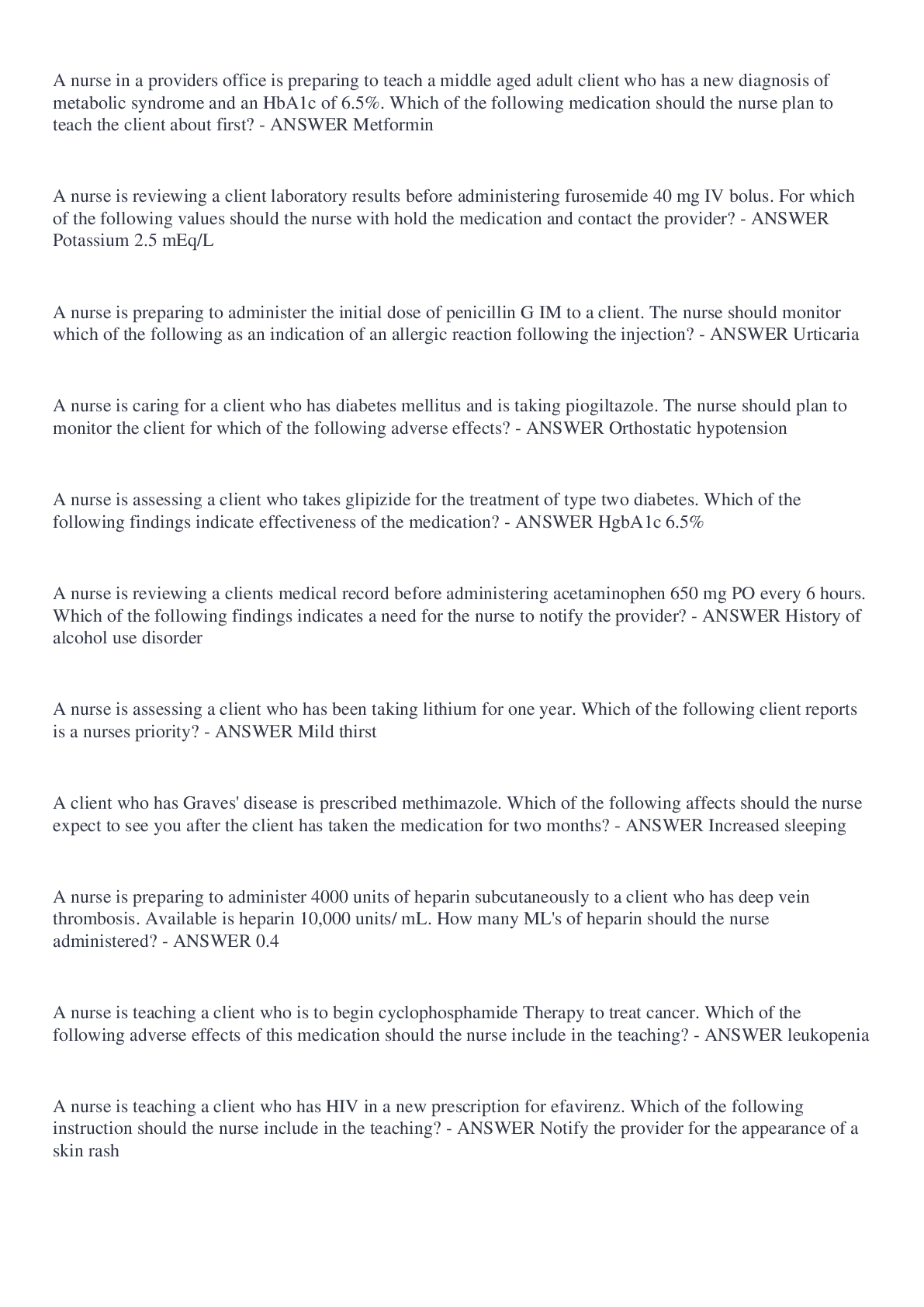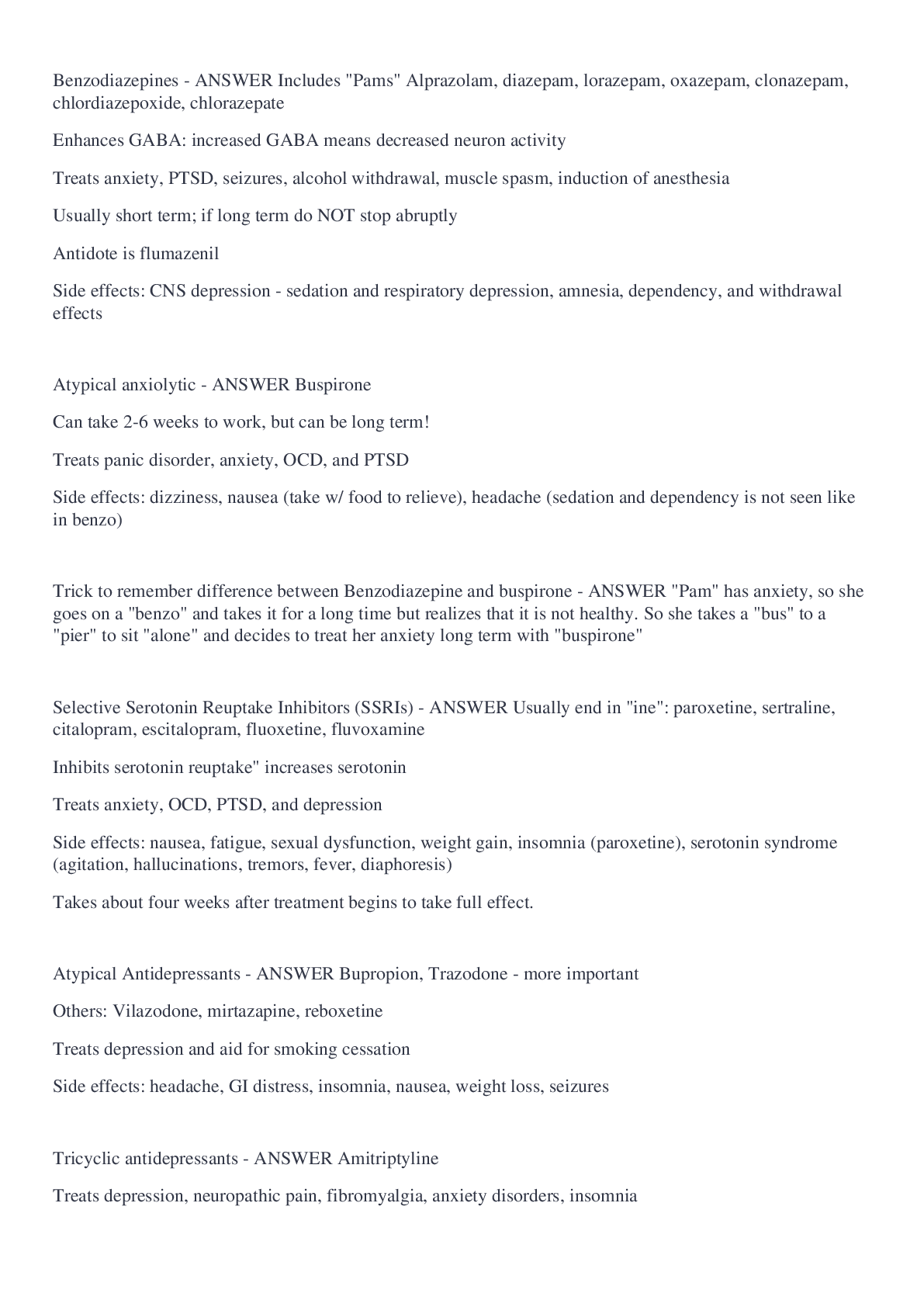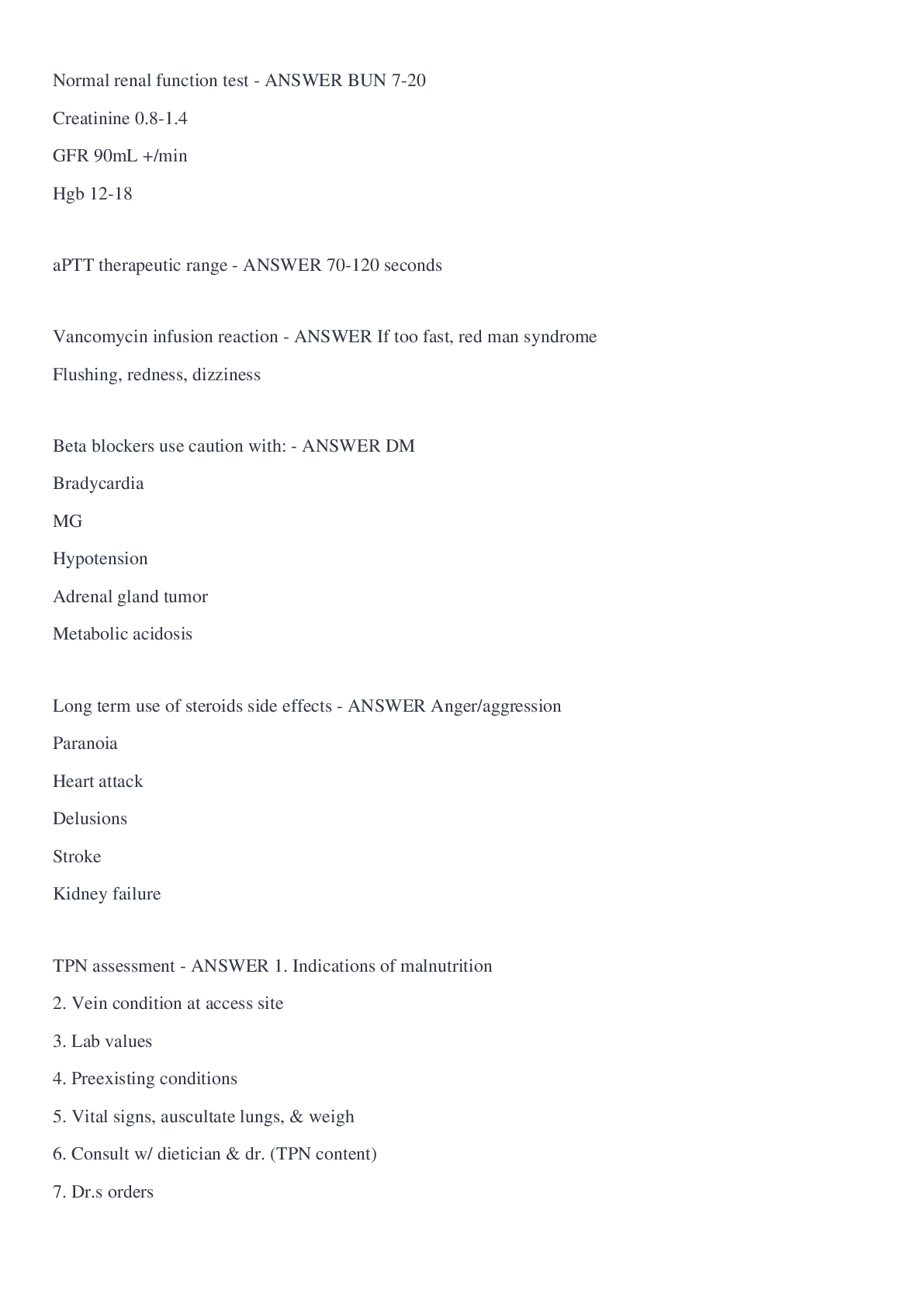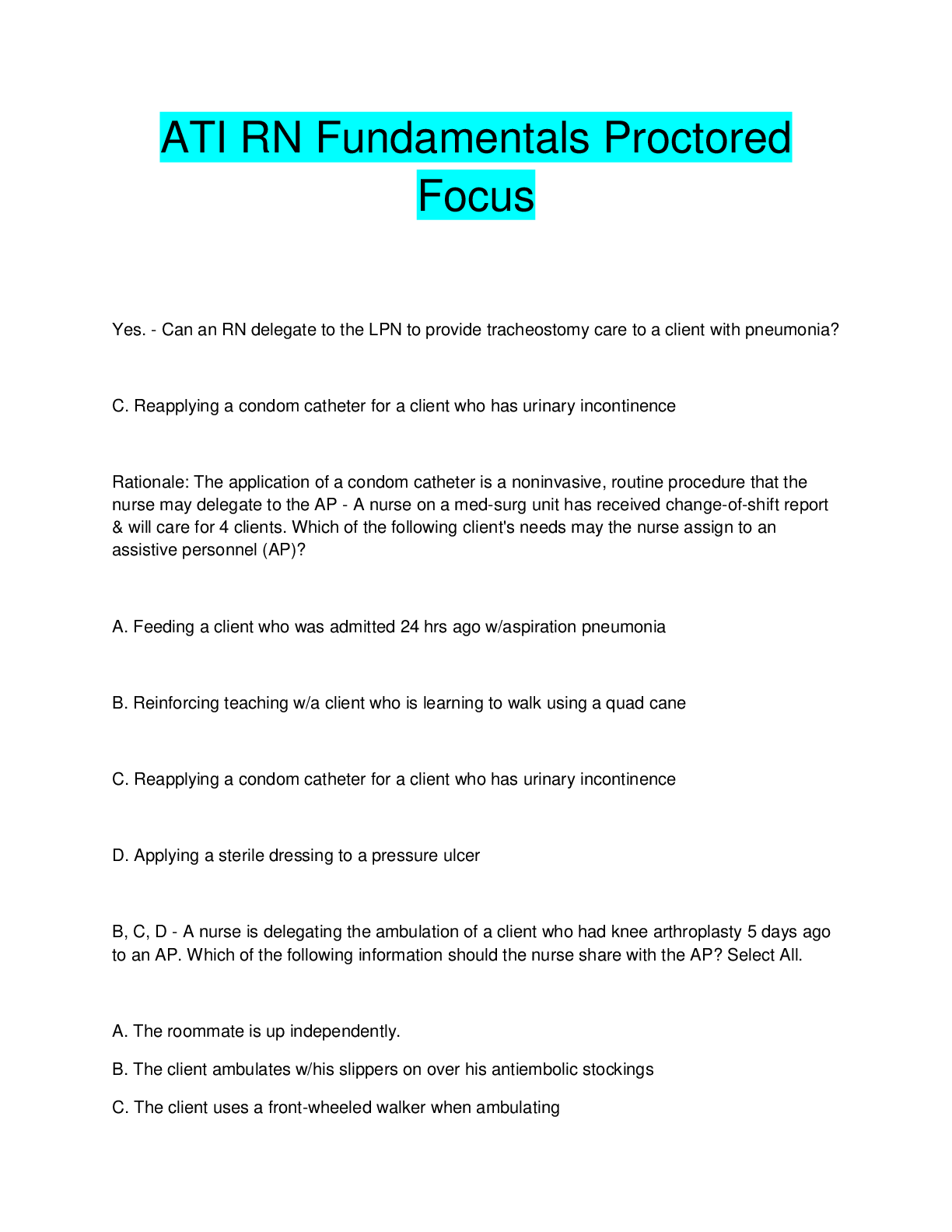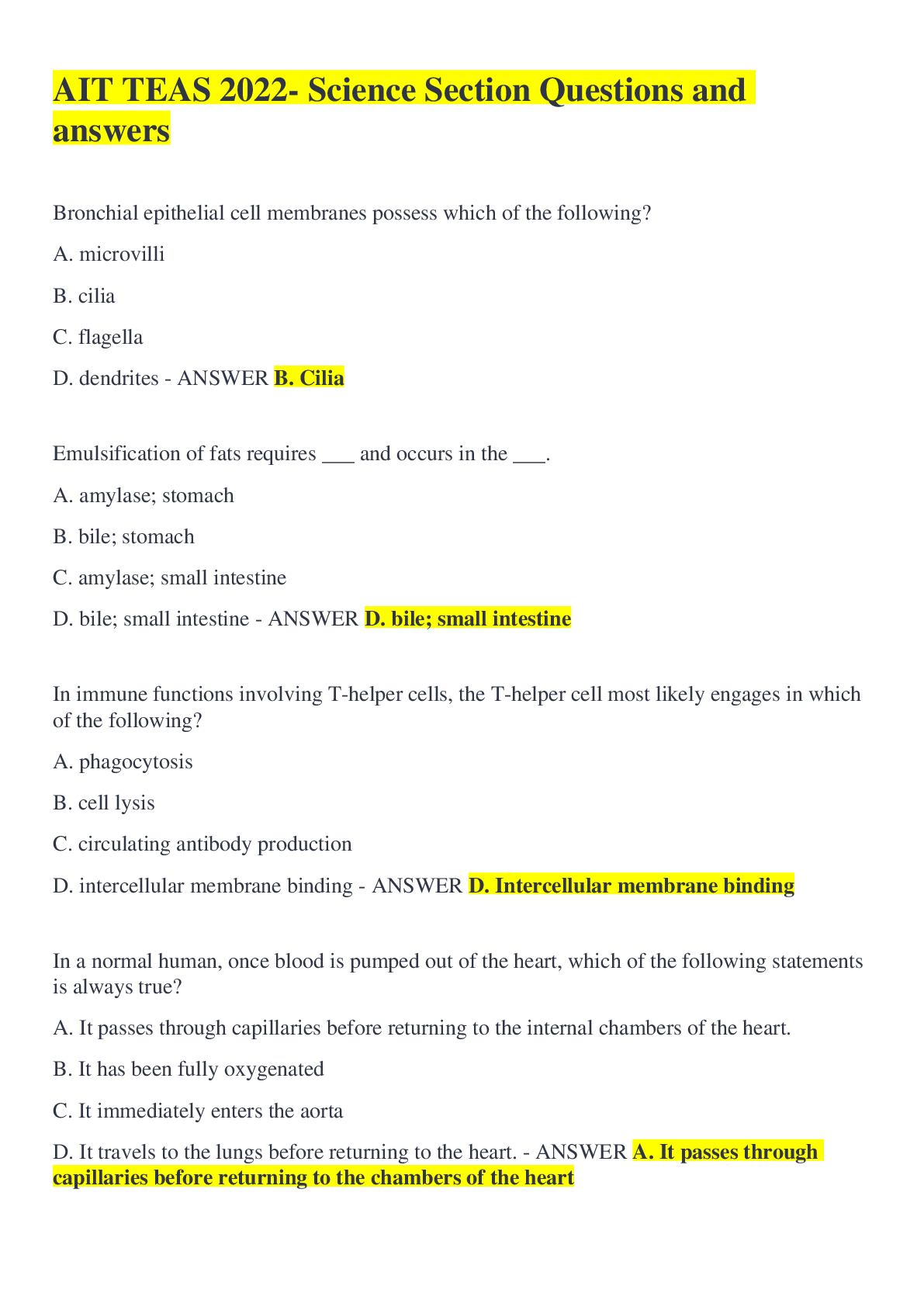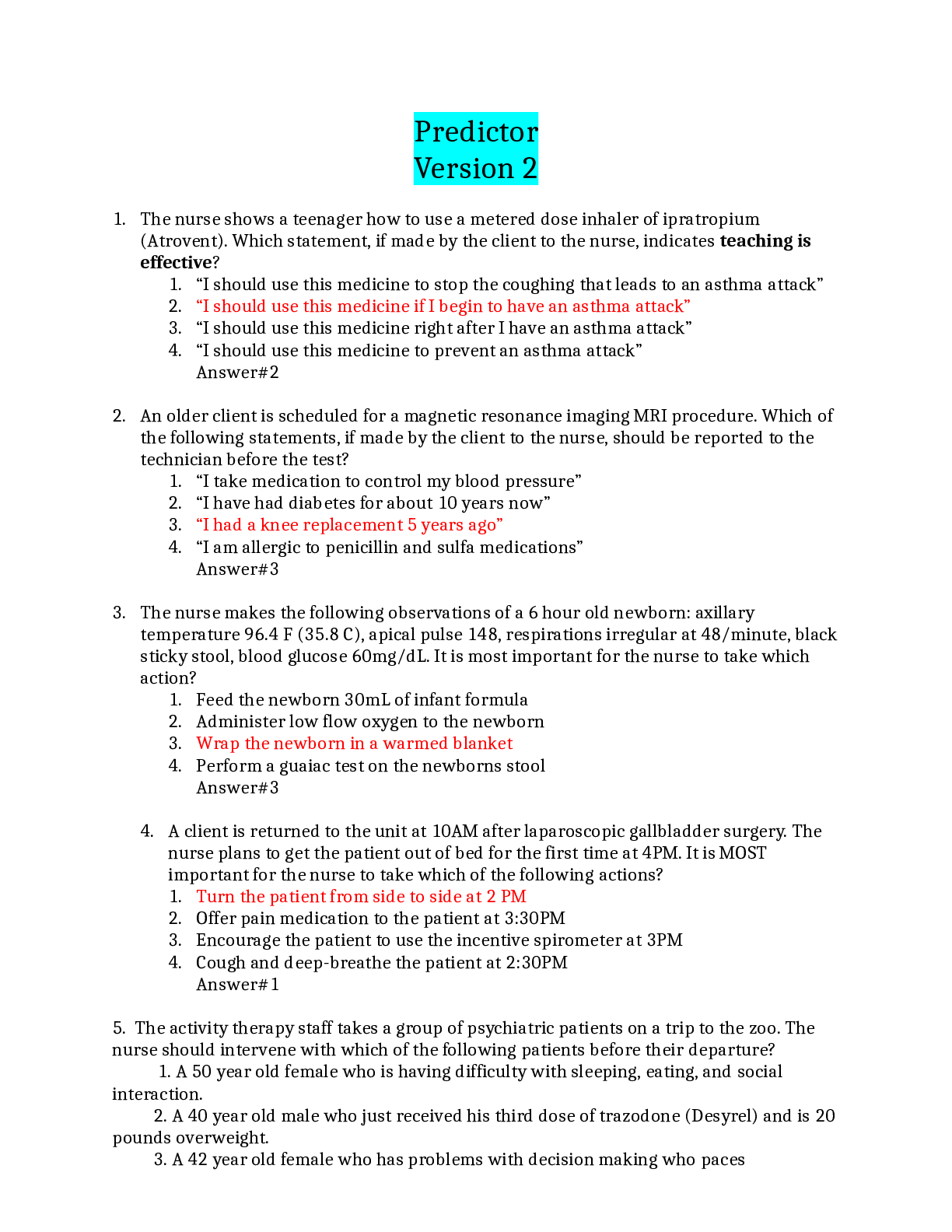Health Care > ATI > Exam #1 Mental Health Exam Questions and Answers (All)
Exam #1 Mental Health Exam Questions and Answers
Document Content and Description Below
1. One characteristics of mental health that allows people to adapt to tragedies, trauma, and loss is: A. Dependence B. Resilience C. Pessimism D. Altruism - ANSWER B. Resilience 2. You and Jac... k are two of the nurses working on the psychiatric unit. Jack mentions to you that the biological model for mental illness is the one he embraces, and states "it's the only one I really believe." Which of the following statements is true regarding believing in only the biological model? A. The biological model is the oldest and most reliable model for explaining mental illness. B. The biological model does not explain every symptom of mental illness. C. The biological model is the most popular theory among leading psychiatrists and therefore the one that should be fully embraced. D. In believing only the biological model, other influences on mental health including cultural, environmental, social, and spiritual influences are not taken into account. - ANSWER D. In believing only the biological model, other influences on mental health including cultural, environmental, social, and spiritual influences are not taken into account. 3. Vanessa's provider writes orders including medication to treat her depression. Based on current understanding of brain physiology, which of the following neurotransmitters would you expect to see targeted c the medication ordered? A. Dopamine B. GABA C. Serotonin/Norepinephrine D. Acetylcholine - ANSWER C. Serotonin/Norepinephrine 4. Which of the following structural safety precautions is most important to prevent the most common type of inpatient suicides? A. Break-away closet bars to prevent hanging B. Bedroom and dining areas with locked windows to prevent jumping C. Double-locked doors to prevent escaping from the unit D. Platform beds to prevent crush injuries - ANSWER A. Break-away closet bars to prevent hanging 5. Josefina Juarez, aged 36 years, comes to the mental health clinic where you work after being referred by her primary care provider. Josefina came to live in the US from Brazil 5 years ago. She is now a single mother to 6 children, ages 2 to 15, following the death of her husband last year. During the initial intake assessment, Josefina tells you her problem is that she has headaches and backaches "almost every day" and "can't sleep at night." She shakes her head no and looks away when asked about anxiety or depression and states she does not know why she was referred to the mental health clinic. You recognize that Josefina may be exhibiting: A. regression. B. somatization. C. enculturation. D. assimilation. - ANSWER B. somatization 6. You are working on an inpatient psychiatric unit and caring for Elizabeth, who is becoming agitated. You speak with Elizabeth one to one in a private setting, finding out the reason for the agitation, and then assist Elizabeth with ways to calm down, possibly including prn medication to prevent further escalation of Elizabeth's agitation, which could lead to seclusion and/or restraints. You are making care decisions based on: A. Writ of habeas corpus B. Least restrictive alternative doctrine C. Veracity D. Bioethics - ANSWER B. Least restrictive alternative doctrine 7. Joel is a 43-year-old patient being seen in the mental health clinical c depression. Joel states "I have always been a practicing Jew, but in the past few mos. I am questioning everything. I just don't know if I believe in it anymore. Which of the following nursing diagnoses best describes Joel's comment? A. Ineffective coping B. Spiritual distress C. Risk for self-harm D. Hopelessness - ANSWER B. Spiritual distress 8. Your patient, Emma, is crying in your one-to-one session while telling you of her father's recent death from a car accident. Which of the following responses illustrates empathy? A. "Emma, I'm so sorry. My father died 2 years ago, so I know how you are feeling." B. "Emma, you need to focus on yourself right now. You deserve to take time just for you." C. "Emma, that must have been such a hard situation to deal with." D. "Emma, I know that you will get over this. It just takes time." - ANSWER C. "Emma, that must have been such a hard situation to deal with." 9. You enter the room of Andrea, a patient on the psychiatric unit. Andrea is sitting with her arms crossed over her chest and her left leg rapidly moving up and down, and she has an angry expression on her face. When you approach her, she states harshly, "I'm fine! Everything's great." Which of the following is true regarding verbal and nonverbal communication? A. Verbal communication is always more accurate than nonverbal communication. B. Verbal communication is more straightforward, whereas nonverbal communication does not portray what a person is thinking. C. Nonverbal and verbal communication may be different; nurses must pay attention to the nonverbal communication being presented to get an accurate message. D. Nonverbal communication is about 10% of all communication, and verbal communication is about 90%. - ANSWER C. Nonverbal and verbal communication may be different; nurses must pay attention to the nonverbal communication being presented to get an accurate message. 10. Advantages of groups include: (Select all that apply.): A. Feedback from peers B. Treatment of multiple people at one time C. Promotion of independence by problem solving D. Provision of an opportunity to practice communication E. Promotion of a feeling of belonging F. Promotion of confidentiality - ANSWER A. Feedback from peers B. Treatment of multiple people at one time D. Provision of an opportunity to practice communication E. Promotion of a feeling of belonging 11. What is currently the most accepted explanation for mental illness? A. Diathesis-stress model (biological predisposition AND environmental stress/trauma or nature-plus-nurture) B. Family history of mental illness; e.g., depression, schizophrenia C. Physically, emotionally and/or sexually abusive parents D. Nature E. Nurture F. Stresses of nursing school - ANSWER A. Diathesis-stress model (biological predisposition AND environmental stress/trauma or nature-plus-nurture) 12. The presence of which symptom will exert the greatest pressure to admit an individual to an inpatient psychiatric unit? A. Suicidal ideation B. Moderate anxiety C. Feelings of sadness D. Auditory hallucinations E. Visual hallucinations - ANSWER A. Suicidal ideation 13. _________________ is the admission to a facility without the patient's consent. A. Voluntary admission B. Involuntary admission C. Informal admission D. Temporary admission E. General admission - ANSWER B. Involuntary admission 14. To provide appropriate care for a patient admitted involuntarily to a psychiatric unit and before court-ordered tx, the nurse must be aware of the fact that the patient has the right to: A. Refuse psychotropic medications B. Be treated by unit staff of his or her choice C. Be released within 24 hours of making a written request D. Have a consultation with other mental health professionals at the hospital's expense - ANSWER A. Refuse psychotropic medications 15. What is the general rule in terms of placing patients in restraints and seclusion? A. Least restrictive and longest duration B. Most restrictive and longest duration C. Least restrictive and shortest duration D. Most restrictive and shortest duration - ANSWER C. Least restrictive and shortest duration 16. What is the order of nursing interventions in order to calm an agitated patient? A. Physical/mechanical interventions (restraint and seclusion), verbally ask for patient's cooperation, medication/chemical interventions B. Verbally ask for patient's cooperation, medication/chemical interventions, physical/mechanical interventions (restraint and seclusion) C. Medication/chemical interventions, verbally ask for patient's cooperation, physical/mechanical interventions (restraint and seclusion) D. Verbally ask for patient's cooperation, physical/mechanical interventions (restraint and seclusion), medication/chemical interventions - ANSWER B. Verbally ask for patient's cooperation, medication/chemical interventions, physical/mechanical interventions (restraint and seclusion) 17. What is it called when the patient unconsciously and inappropriately displaces onto the health care professional feelings and behaviors related to significant figures in the patient's past? For example, the patient may inform the nurse. "You remind me of my mother." A. Sympathy B. Countertransference C. Empathy D. Transference E. Neuropathy - ANSWER D. Transference 18. What is it called when the health care professional unconsciously and inappropriately displaces onto the patient feelings and behaviors related to significant figures in the health care professional's past? For example, a nurse who is struggling with an alcoholic family member feels disgusted toward an alcoholic patient. A. Sympathy B. Countertransference C. Empathy D. Transference E. Neuropathy - ANSWER B. Countertransference 19. During group therapy, a depressed patient talks about losing his beloved pet recently. The nurse leading the group therapy begins to cry, too, as it is the one-year anniversary since her own dog passed away. The nurse is experiencing _________ for the patient. A. Sympathy B. Countertransference C. Empathy D. Transference E. Neuropathy - ANSWER A. Sympathy 20. If the patient asks the nurse to keep a secret, the nurse's best response would be: A. "Your secret will be safe with me." B. "I cannot make that promise. It might be important for me to share it with other staff." C. "All of your information is confidential." D. "Because of HIPAA, I can't disclose your secret." E. "I took the oath of Omerta." - ANSWER B. "I cannot make that promise. It might be important for me to share it with other staff." 21. Asking "why" questions is an example of a: A. Therapeutic communication technique B. Nontherapeutic communication technique - ANSWER B. Nontherapeutic communication technique 22. Which statement by a nurse would be considered nontherapeutic? A. "I'm not sure I understand what you mean." B. "Tell me more about what happened when you resigned." C. "I see that you are wringing your hands as we talk about the job interview." D. "I know EXACTLY how you feel!" - ANSWER D. "I know EXACTLY how you feel!" 23. Jerry is a 72-year-old patient c Parkinson's disease and anxiety. He is living by himself and he has had an unsteady gait lately. His provider orders lorazepam (Ativan), 1 mg PO bid for anxiety (Ativan is a benzodiazepine.). You question this order because: A. Jerry may become addicted faster than younger patients. B. Jerry is at increased risk for falls. C. Jerry has a hx of nonadherence c medications. D. Jerry should be treated c cognitive therapies rather than medication because of his advanced age. - ANSWER B. Jerry is at increased risk for falls. 24. A nurse administering a benzodiazepine should understand that the therapeutic effect of benzodiazepines results from potentiating the neurotransmitter: A. Serotonin B. Dopamine C. Acetylcholine D. Gamma-aminobutyric acid (GABA) - ANSWER D. Gamma-aminobutyric acid (GABA) 25. Which nursing action is NOT useful in promoting delivery of culturally relevant psychiatric mental health nursing care? A. Providing a culturally relevant patient assessment B. Working within the cultural context of the patient C. Using direct eye contact and touch to facilitate communication D. Bridging the gap between the U.S. health care system and the health belief system of the patient - ANSWER C. Using direct eye contact and touch to facilitate communication 26. Carrie Bradshaw, 34-years-old, is depressed about being single and unable to find the right man willing to make a commitment. Based on Erikson's Eight Stages of Development, Carrie is experiencing the psychosocial crisis called: A. Trust vs. mistrust B. Industry vs. inferiority C. Identity vs. role confusion D. Intimacy vs. isolation E. Integrity vs. despair - ANSWER D. Intimacy vs. isolation 27. Lithium has a _____________________ therapeutic index. A. Low B. High - ANSWER A. Low 28. A _________ therapeutic index means that the blood level of a drug that can cause death is not far above the blood level required for drug effectiveness. A. Low B. High - ANSWER A. Low 29. Lithium is a(n) _______________________ used to treat _______________. A. Antipsychotic and schizophrenia B. Antianxiety (anxiolytic) and anxiety C. Mood stabilizer and bipolar disorder D. Antidepressant and depression E. Anticonvulsant and bipolar disorder - ANSWER C. Mood stabilizer and bipolar disorder 30. What are the early adverse/toxic effects of lithium or the S/S a RN should be alert for in a patient on lithium? A. Fever, cough, sore throat B. Ataxia, tremor, confusion C. Extrapyramidal symptoms; e.g., akinesia, akathisia, parkinsonism D. Hypertension, severe headache, tachycardia E. Rash - ANSWER B. Ataxia, tremor, confusion 31. Patients who have anxiety disorders have a(n) _____________ of the neurotransmitter GABA and a(n) ____________of the neurotransmitter norepinephrine. A. Increase and increase B. Decrease and decrease C. Increase and decrease D. Decrease and increase - ANSWER D. Decrease and increase 32. Depressed patient have a(n) ________________ of the neurotransmitter norepinephrine and a(n) _____________________ of the neurotransmitter serotonin. A. Increase and increase B. Decrease and decrease C. Increase and decrease D. Decrease and increase - ANSWER B. Decrease and decrease 33. Schizophrenic patients have a(n) ________________ of the neurotransmitter dopamine. A. Increase B. Decrease - ANSWER A. Increase 34. Patients who have Alzheimer's Disease have a(n) ____________ of the neurotransmitter acetylcholine. A. Increase B. Decrease - ANSWER B. Decrease 35. Patients taking this class of medications must avoid foods high in tyramine: A. SSRIs B. MAOIs C. TCAs D. Anticonvulsants E. Benzodiazepines - ANSWER B. MAOIs 36. Foods that contain tyramine to avoid include: A. Yogurt, broccoli, oranges B. Aged cheeses, pickled/smoked fish, fermented meats C. Milk, blueberries and fresh meats D. Eggs, shellfish and iodine - ANSWER B. Aged cheeses, pickled/smoked fish, fermented meats 37. ____________________ are generally considered 1st-line treatment for depression. A. MAOIs B. SSRIs C. TCAs D. Lithium E. Anticonvulsants - ANSWER B. SSRIs [Show More]
Last updated: 2 years ago
Preview 1 out of 12 pages

Buy this document to get the full access instantly
Instant Download Access after purchase
Buy NowInstant download
We Accept:

Reviews( 0 )
$7.00
Can't find what you want? Try our AI powered Search
Document information
Connected school, study & course
About the document
Uploaded On
Sep 26, 2022
Number of pages
12
Written in
Additional information
This document has been written for:
Uploaded
Sep 26, 2022
Downloads
0
Views
43

